Hairless dog breeds are among the rarest and most interesting types of canines and they are sure to catch your attention as soon as you start reading this article.
Dogs can be found in different colors, coat types, sizes, and have various other characteristics. Some pups have long coat hair, some have short hair, and some have little to no hair!
Hairless dog breeds are quite rare nowadays, which makes them a better choice for people who are looking for more unique canine breeds.
Unfortunately, there aren’t many hairless dog breeds left, since most of them are already extinct. That’s why it’s crucial to learn as much as possible about them and preserve them from extinction.
How Many Different Breeds Of Hairless Dogs Are There?
1. Xoloitzcuintli
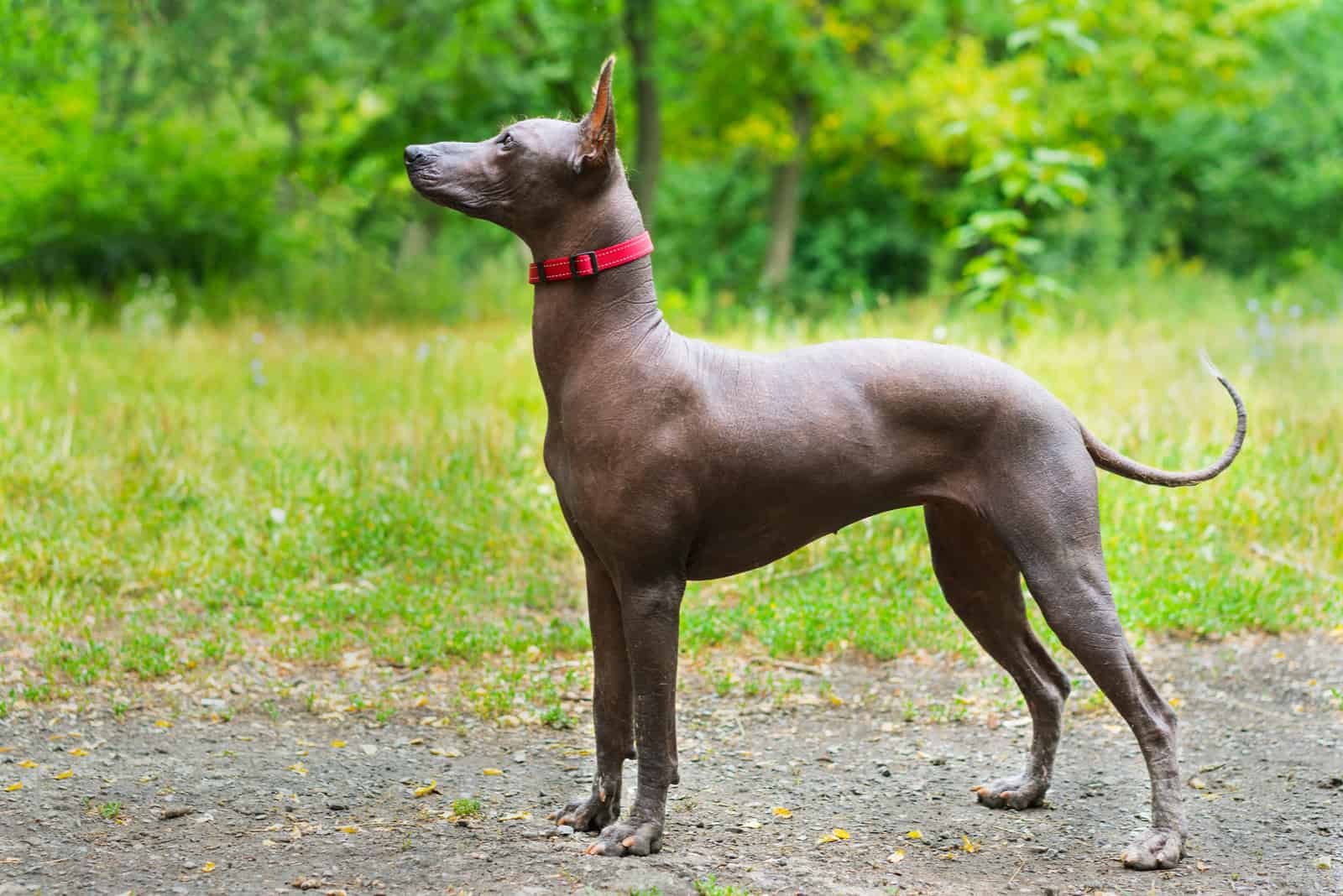
Pronounced as “show-low-eats-queent-lee“ (you’re welcome), this canine breed has been gaining popularity in the United States for the past few years, so it doesn’t surprise me that there are more and more Xolo breeders appearing in the U.S.
It is one of the less well known hairless pups, especially when compared to the American Hairless Terrier. Still, I’m sure that it’ll become one of the favorite canine breeds among hairless-dog enthusiasts in the future.
The American Kennel Club (AKC) placed this type of canine into the non-sporting dog category. According to the AKC breed standard, this is an ancient type of canine that only grows to a maximum of 24 inches.
They come in two versions, the hairless version and a version with a short coat, although the former are more popular.
Xolos are also popularly known as Mexican Hairless Dogs, as they date back to the period of the Aztecs and the people of Aztlan, famously known as Mexico today.
Temperament
The Xoloitzcuintli is a very intelligent, ancient breed of canine and is often underrated among the more popular watchdog breeds, even though it has a long history of being one.
These pups are quite unique for several reasons, including their instincts, which are considered “primitive” in modern times but have helped them survive for thousands of years.
Xolos are fantastic family pets; they’re open to everyone, even though they might feel a bit more reserved towards people they don’t know, but only until they make initial contact.
These pups were popular as watchdogs during ancient times, so don’t be surprised if your pup shows its protective nature whenever they notice someone unfamiliar getting close to you.
They are fiercely loyal and obedient to their owners, but they also manage well with other animals in the house, which is why they’re considered a perfect match for families who have multiple pets.
Of course, just like the majority of dog breeds, they have their good and bad days, but overall, these pooches will never let you down.
2. American Hairless Terrier
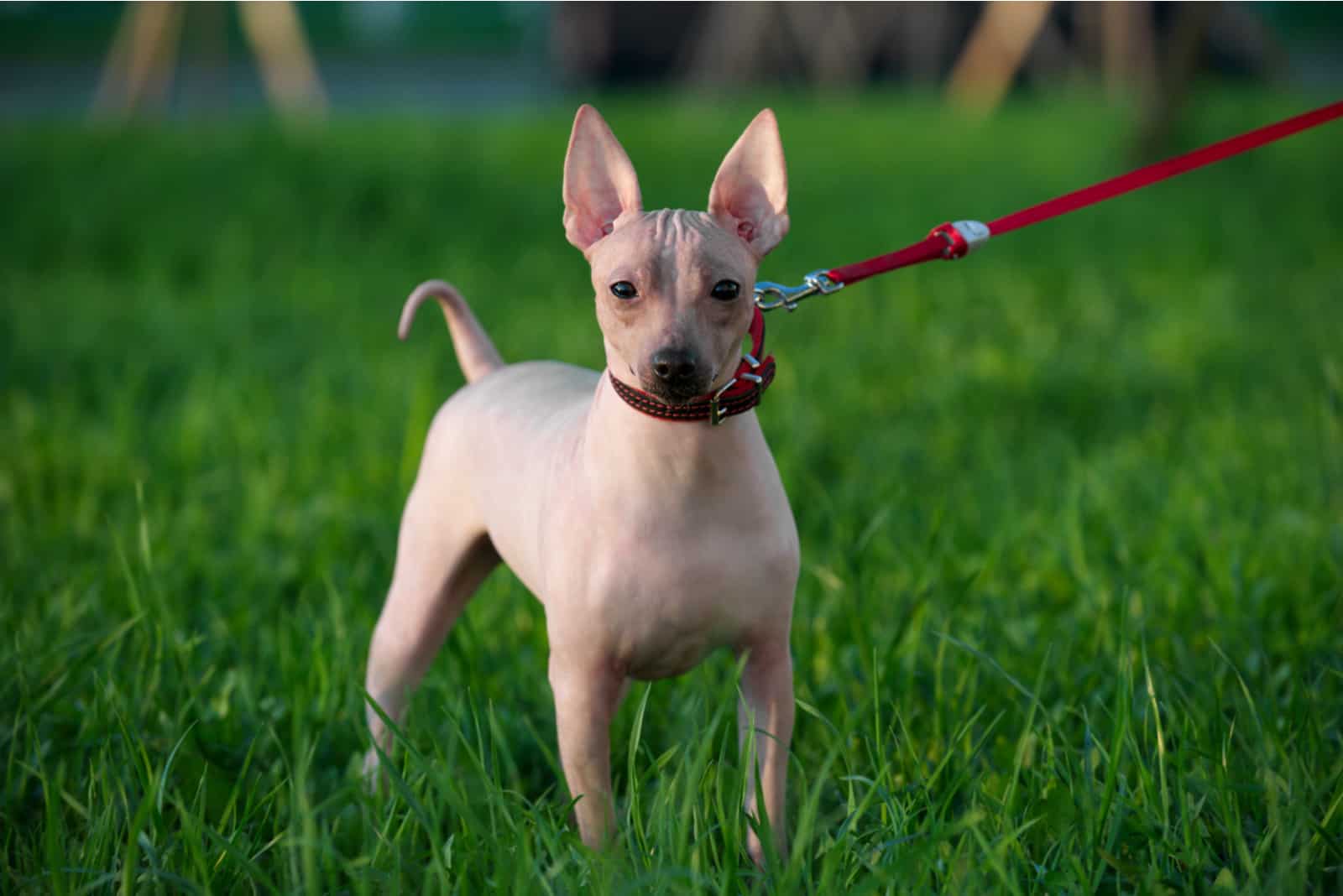
Many will agree that this is one of the most popular hairless dog breeds in the U.S. and beyond. The fact that the AKC has accepted this hairless breed, tells us enough about the quality of this canine.
The idea for this type of dog was born around 50 years ago in Louisiana. The main concept was to selectively breed a hypoallergenic canine breed that was suitable for dog lovers who have strong allergic reactions to dog hair.
Hypoallergenic canines weren’t anything new at that time; there were many breeds that were considered suitable for allergy sufferers, such as Schnauzers, Yorkshire Terriers, Bichon Frises, and others.
However, all of these breeds were either short or long-coated varieties, which could still cause allergic reactions in those with severe dog allergies.
As a result, the hairless Rat Terrier was born and has remained one of the best canine breeds for people with allergies to dog hair.
Temperament
These pups are loyal and obedient pooches that will do everything to keep their owner protected at all costs.
However, just like the majority of pups, they love to explore different places, especially if their environment is changed, which is why they’re great outdoor companions.
You will never get bored with the American Hairless Terrier because they’re funny, joyful, and curious. That’s why these doggies are excellent with kids and might become even better company in the future than Shih Tzus, Corgis, Rottweilers, Golden Retrievers, Labradors, etc.
The American Hairless Terrier is considered to be a small dog, but they have big hearts and plenty of love for their human families.
However, be prepared for a few challenges, as well, since these canines are known to be a bit strong-willed and will not always do as they’re told.
That’s why obedience training for these dogs might take more time than it does for other breeds, but if you start early enough, you’ll already be on the path to success!
RELATED: Toy Rat Terrier: A Small Dog With A Huge Energy Bar
3. Ecuadorian Hairless Dog
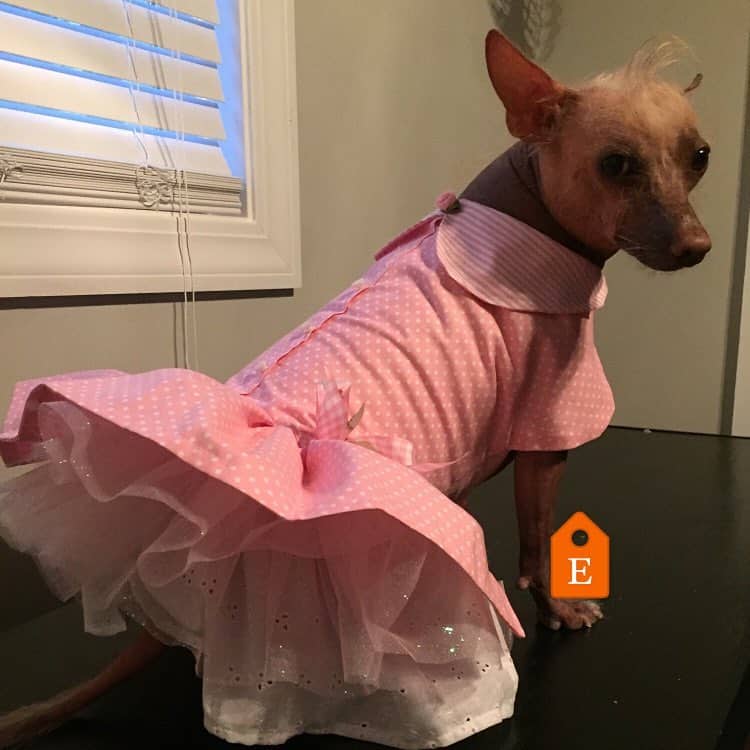
Photo from:@customdogjackets
The AKC has not acknowledged this breed yet, not just because of its rarity but also because of the belief that it is a hybrid canine that was created by mixing Peruvian and Mexican Hairless Dogs.
Ecuadorian Hairless pups come from Ecuador (which is quite logical), but they’re native to a peninsula actually known as the Santa Elena Peninsula.
This breed is characterized by its distinctive look, including hairless skin on all of its body parts, except for a few wiry hairs on the top of their heads.
But, what sets this hairless dog apart from others even more, is the absence of anterior teeth in their mouths.
They can reach a height of up to 16 inches and weigh up to 25 pounds.
Temperament
Not many details are known about this hairless dog breed due to its uncommonness and a lack of reviews from canine owners who are in possession of this breed.
What we do know is that these puppies are as adorable as they look and that they have a great amount of energy, which means that you’ll need to prepare for plenty of outdoor activities.
It’s interesting to notice that Ecuadorian pups have a pretty high prey drive, usually only when it comes to hunting rats, mice, and other rodents that are small in size.
Their prey instinct is part of the heritage of their ancestors, which were actually bred for the sole purpose of hunting. Therefore, even though they’re good with kids, it is better to train them how to socialize with youngsters from early puppyhood.
The Ecuadorian is an enthusiastic and active breed of canine that needs a good deal of daily exercise due to its high activity level. However, they’ll use every chance they get to sit on their owners and relax, knowing that they’re in safe hands.
4. Chinese Crested

Truth be told, these pups have more hair than all the other hairless dog breeds on this list, but they still belong here, and you’ll discover why in the next few paragraphs.
The torso and back of the Chinese Crested’s body are completely hairless, but they do have a large amount of hair on their head (especially around their ears and muzzle).
The hair can also appear on the front part of their paws, although the rest of the legs don’t have any hair. What’s interesting about this breed is that they often have black spots on their belly!
The Chinese Crested does have a full-coated version, which is known as the Powderpuff, they are quite rare because they are produced by a recessive gene.
Chinese Crested dog breeders really have their hands full when developing these unique pups!
Unfortunately, sunburns, dermatitis, and other skin conditions are common issues for the hairless variety, while the coated pups don’t usually suffer with these health issues.
The Chinese Crested has a similar color scheme to their compatriots, the Chinese Shar-Pei. However, that isn’t the only resemblance between these two canines.
Temperament
When it comes to their personality, the Chinese Crested have several traits in common with Shar-Peis as well. Both of these canines can be quite strong-willed, but it’ll still be impossible not to love them!
Chinese Crested dogs are great family companions, they’re amiable towards humans and other animals, but they can also be quite clingy.
These pups love to snuggle with their owners and almost never leave their side; therefore, if you’re not ready for a pup that will probably follow you even to the bathroom, you should consider getting another breed.
These pooches prefer staying inside rather than spending the whole day enjoying outdoor activities, as they only have low-to-medium energy levels.
Also, bear in mind that they easily get sunburns, which is why I recommend that you always have sunscreen nearby for them.
5. Peruvian Inca Orchid

This breed hasn’t been very popular in the United States in the past, but the demand for them has started to rise during the last few decades, even though they were first brought here in the 1960s.
Their name states their homeland, Peru, from which they were taken to other countries.
Also known as the Peruvian Hairless Dog, the Inca Orchid is acknowledged by the Fédération Cynologique Internationale (FCI) and other kennel clubs.
According to the AKC breed standard for Peruvians, they are allowed to have some hair on their head and tails as well (the hair on their head is usually styled as a mohawk).
These pups resemble the Xoloitzcuintli in terms of their physical looks and their temperament too, so don’t be surprised if people confuse them.
It’s important to mention that these pups are excellent sighthounds, very much like the Greyhound. However, Greyhounds shed a lot more than Peruvians, which are hypoallergenic dogs.
Temperament
Peruvian Hairless canines are excellent choices for families who are looking for a pet that can be both a cuddly friend and a watchdog when needed.
Even though it takes them some time to get comfortable with new people, their owners typically think of them as caring and full of love towards their owners and other members of the household.
This canine has a high energy level and is often described as an agile pup, which is why I’d recommend that you make a plan of everyday activities from the day you decide to get one.
One of the things I love the most about this breed is that it’s friendly enough towards people they don’t know, but they’re also careful and might even seem reserved towards them until they get to know them better.
These pooches are obedient to their owners, but since they possess a high prey drive, it is better to avoid leaving them alone with cats.
Their strong urge to hunt is exactly one of the reasons why they need thorough socialization training.
6. Argentine Pila
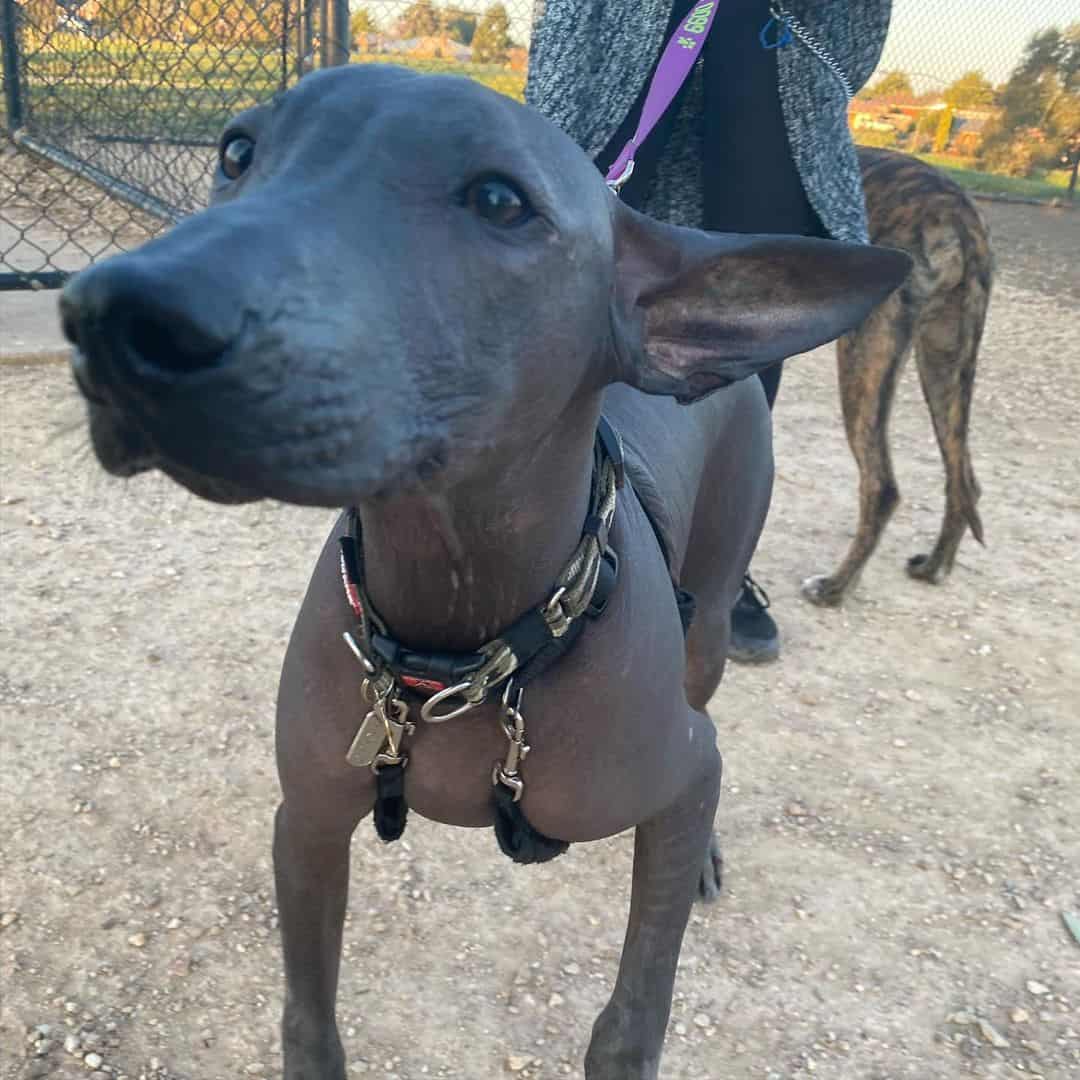
Photo from: @clevercanid
However, a lot of people have found a link between this breed and the Hairless Khalas in terms of their size and their recognizable haircut (the mohawk).
The Argentine Pila dog comes in three different sizes and can grow to anywhere from 10 to 17.5-18 inches.
Their homeland is Argentina (who would have thought), but they can also be found in other parts of the world, including the United States.
When it comes to their physical appearance, some people even compare the size of these canines to the Miniature Pinscher, although their robust look resembles the standard ones more.
They are incredibly agile canines that are able to jump, run, or climb anywhere they want with little to no energy because of the peculiar body shape that they possess.
This breed also comes in a coated version, which is pretty much the same as the Chinese Crested coated pup. However, the coated Argentine Pila pups are considered “faulty,” which is why they will hardly ever be bred on purpose.
Temperament
This pup is a lively and active breed of dog that enjoys spending time outside running and playing.
They are aware of their own ability to surprise opponents with their athleticism on the field. Therefore, you can be sure that hardly anyone will be able to keep up with their pace.
Despite this, these canines are simple to train, as they will do anything to please their owners and obey their commands.
Argentine Pila pups have the potential to be excellent guard dogs. They have the attitude of a guard dog; they are interested in new people, yet wary around them.
They might bark just as much as Dachshunds, Border Collies, or Cocker Spaniels, but they’re not hostile and won’t cause any damage to anyone.
These pups are also great furry friends and companion dogs to children, so you don’t have to worry about letting them play together.
Argentine Pila dogs are excellent pets if you live in an apartment because they require minimum grooming. However, you should pay more attention to their skincare, especially when you go outside during summer.
7. Abyssinian Sand Terrier
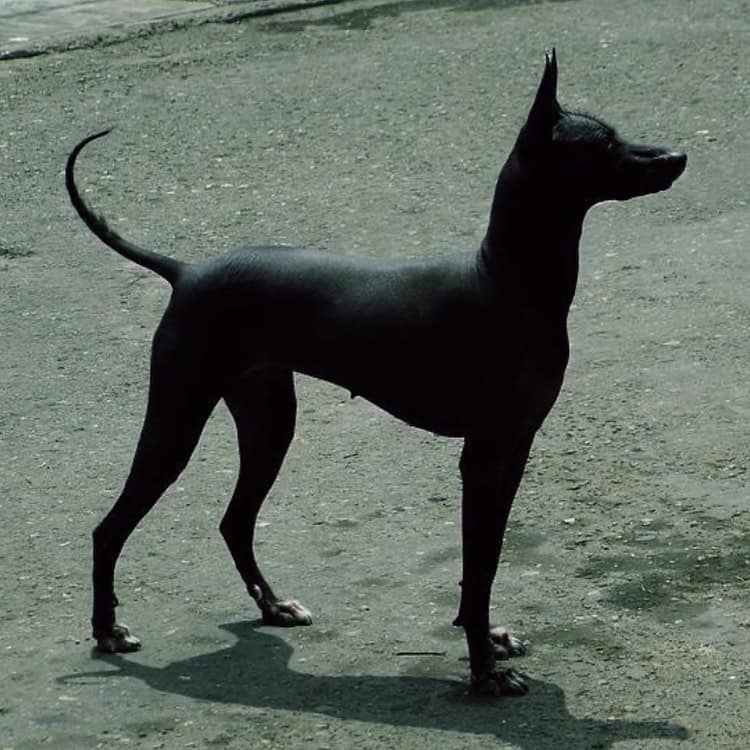
Photo from:@dog.breeds.daily
It’s a type of Terrier canine and hails from Africa, which is why many people also know them as African Hairless Dogs.
A few of them have tufts of hair on their heads and at the very end of their tails, while others are entirely hairless.
Another interesting thing about this type of dog is the shape of their ears, they have a bat-like ear shape rather than that of a regular canine.
The majority of their bodies are usually covered in a shadowy-gray color with bright (pink) spots scattered throughout.
Even though they are lean canines, these pups have the potential to be as energetic as any other canine.
Temperament
One of the things that might be surprising to many canine enthusiasts is that these canines don’t possess the ability to bark, which is why they need to be trained on how to bark properly, according to the words of dog owners with rich experience with this breed.
Another thing that they’re also famous for is their lack of fear and anxiety. They won’t let the fact that they are small in size get in the way of them protecting their family and home.
As a result, they are perfect candidates for excellent watchdogs, even though most will find them unsuitable for use as guard dogs.
They have an unbreakable commitment to their loved ones, which is one of the reasons why they place such a high priority on the defense of their family.
These pups might not be on such good terms with unfamiliar people, but once they get to know you, you will easily become one of their favorites.
They’re really good with children and like to spend time playing with them, although they shouldn’t be left with them without supervision, especially if the children are still babies or toddlers.
8. Jonangi Dog
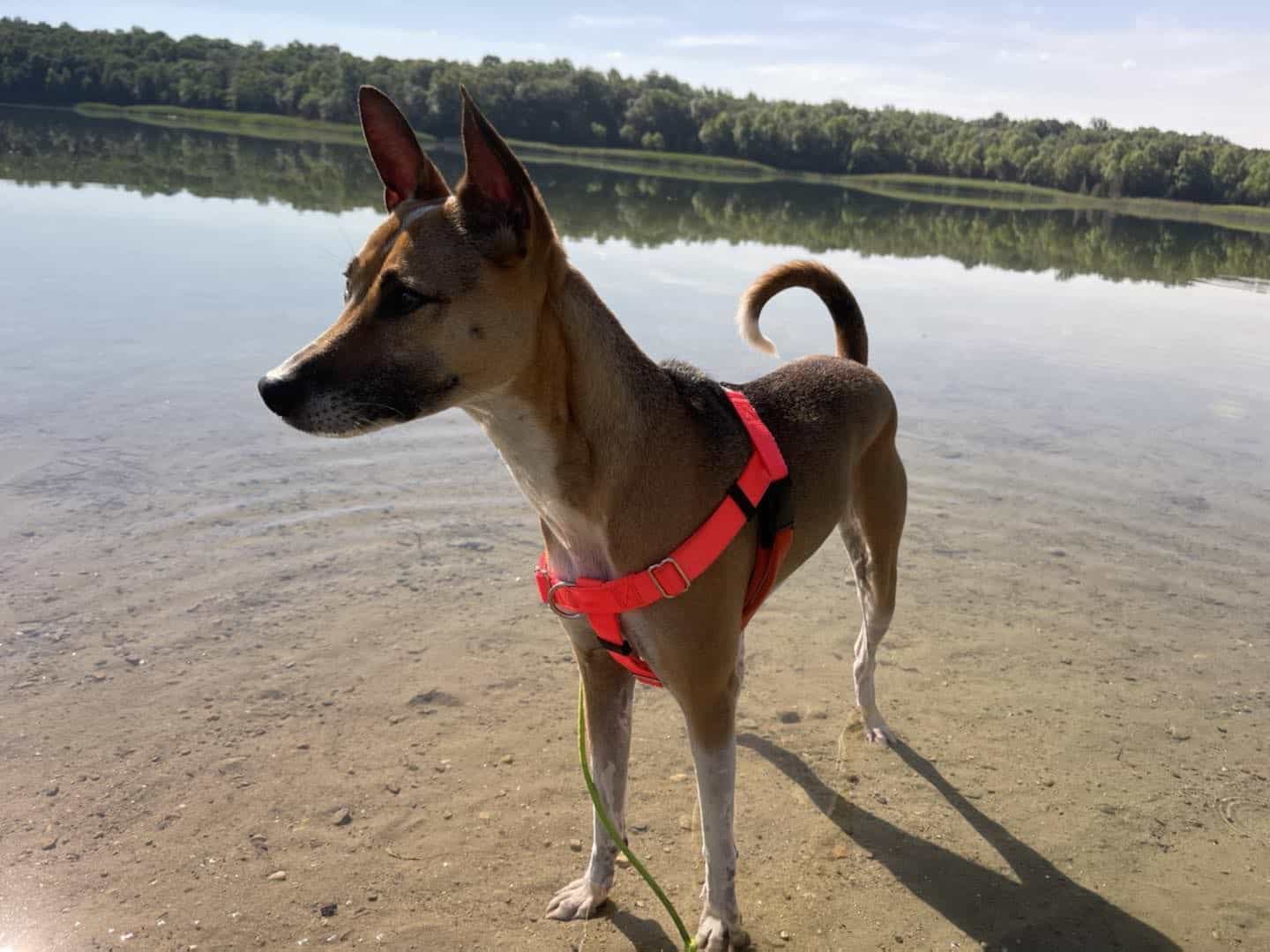
Photo from:@goddess_matsya
This is a talented dog that can be used for a variety of purposes. In the past, they were mainly used for duck-herding, but this use for them has experienced a significant drop in the last few decades.
This meant that a great number of canines were left without one of the main reasons they were bred for, which is why they ended up on the streets as homeless pups.
However, even though this was a harsh experience for these pups, it helped them to learn how to become more independent.
When it comes to their looks, these pups are a canine type that entirely deserves the title of a hairless dog breed.
They don’t have any hair on their skin, not even small tufts of fur like some of the other breeds. They come in several different colors, including gray, beige, brindle, or white with dark spots, which always reminds me of the Dalmatian color pattern (although they do have fur).
Temperament
This is a breed that can function in a family of multiple members, but they’ll always be fully attached to only one person.
Therefore, if you notice that your pup is constantly following you and not your partner or any other family member, it’s just part of their nature.
However, there’s no need to fear, as these issues can be resolved by simply including your pup in socialization training from early puppyhood.
The Jonangi dog is a very lively and dynamic individual, especially when they need to complete certain tasks. After all, these pups were raised to run and swim faster than the majority of other breeds.
On land, as well as in the water, they are renowned for their dexterity and lightning-fast speeds. They are able to outpace the majority of animals thanks to their big steps.
9. Hairless Chihuahua
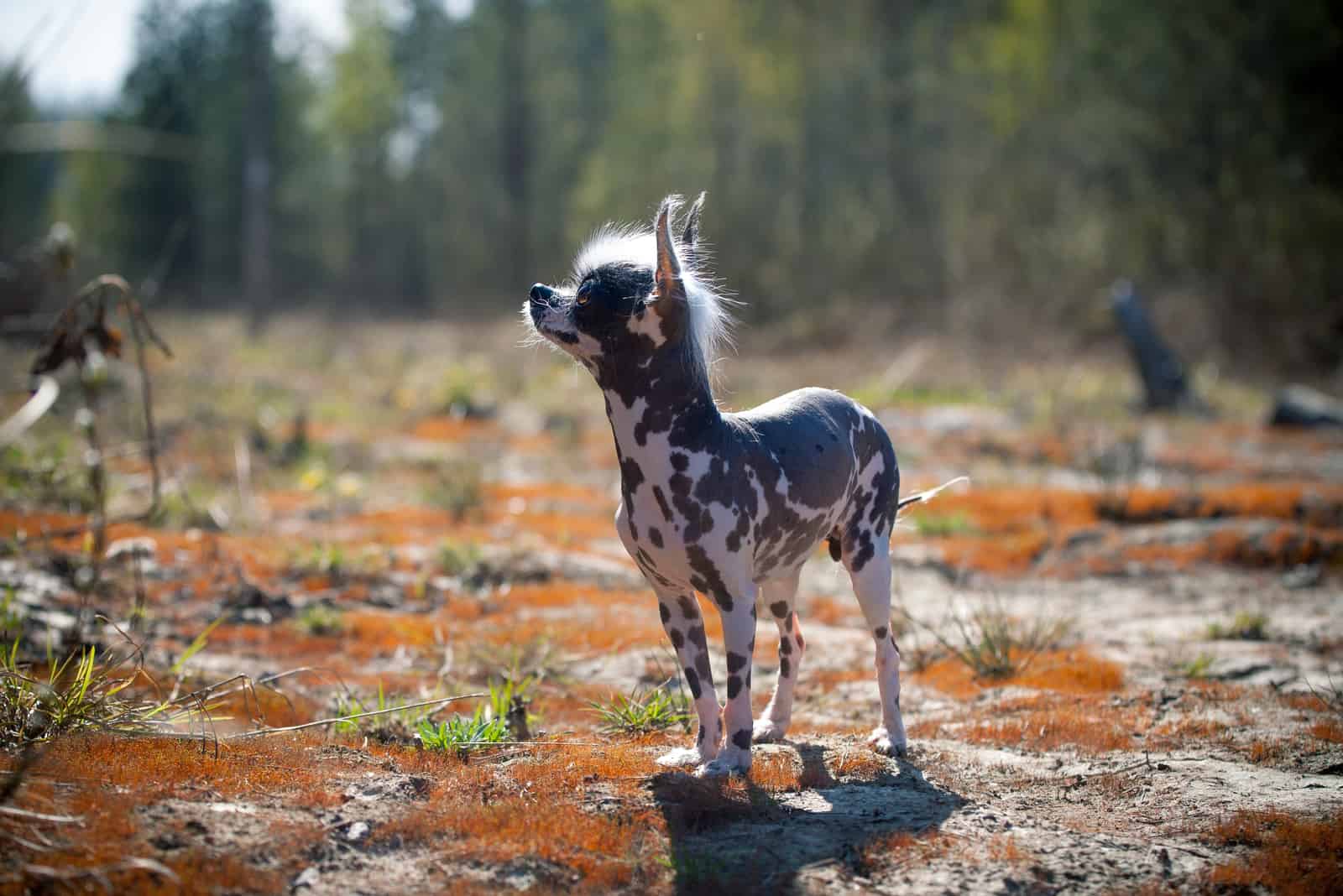
Either coated or without hair, these pups are among the most famous tiny dog breeds in the U.S. and the rest of the world as well.
It might be a bit surprising to discover that there are several types of Chihuahuas. They are all tiny pups but some have no hair, some are single-coated, and some are double-coated canines (the last one is rare, but it does exist).
It’s interesting to note that these pups are often confused with Xolo pups. As funny as this may sound at first, because these two differ in almost every aspect of their physical appearance, the confusion is based on their names.
Chihuahuas are commonly called Mexican Hairless dogs, even though this name rightfully belongs to the Xolo dogs.
When it comes to their general appearance, Hairless Chihuahuas have the same traits as their coated varieties, including their lifespan, size, and common health issues (although the hairless versions require more attention to their skincare).
Temperament
Experienced dog owners are very familiar with the temperament and personality traits of Chihuahuas, who are tiny dogs with huge vocal ranges.
Being one of the smallest canine breeds hasn’t been an issue for them to show their teeth to anyone who doesn’t play by their rules, be it a child, a human adult, or another animal.
These pups are bold, lively, and full of spirit. The temperaments of these dogs have been compared to that of terriers by several of their owners, which confirms that these pups possess such traits.
This dog breed often has strong instincts to defend their territory and may be highly defensive when it comes to their families. That’s why many people find Chihuahuas aggressive, but I’d rather say that they’re misunderstood.
If you’ve ever had a chance to hear this canine barking, you will realize why they’re considered aggressive.
Some people might hesitate to let their kids play with these doggies, but they do just fine with bigger children, although supervision is still needed in case anything goes wrong.
Chihuahuas aren’t bad; they are doggies that are misunderstood and highly intelligent but strong-willed.
10. Bolivian Hairless Dog
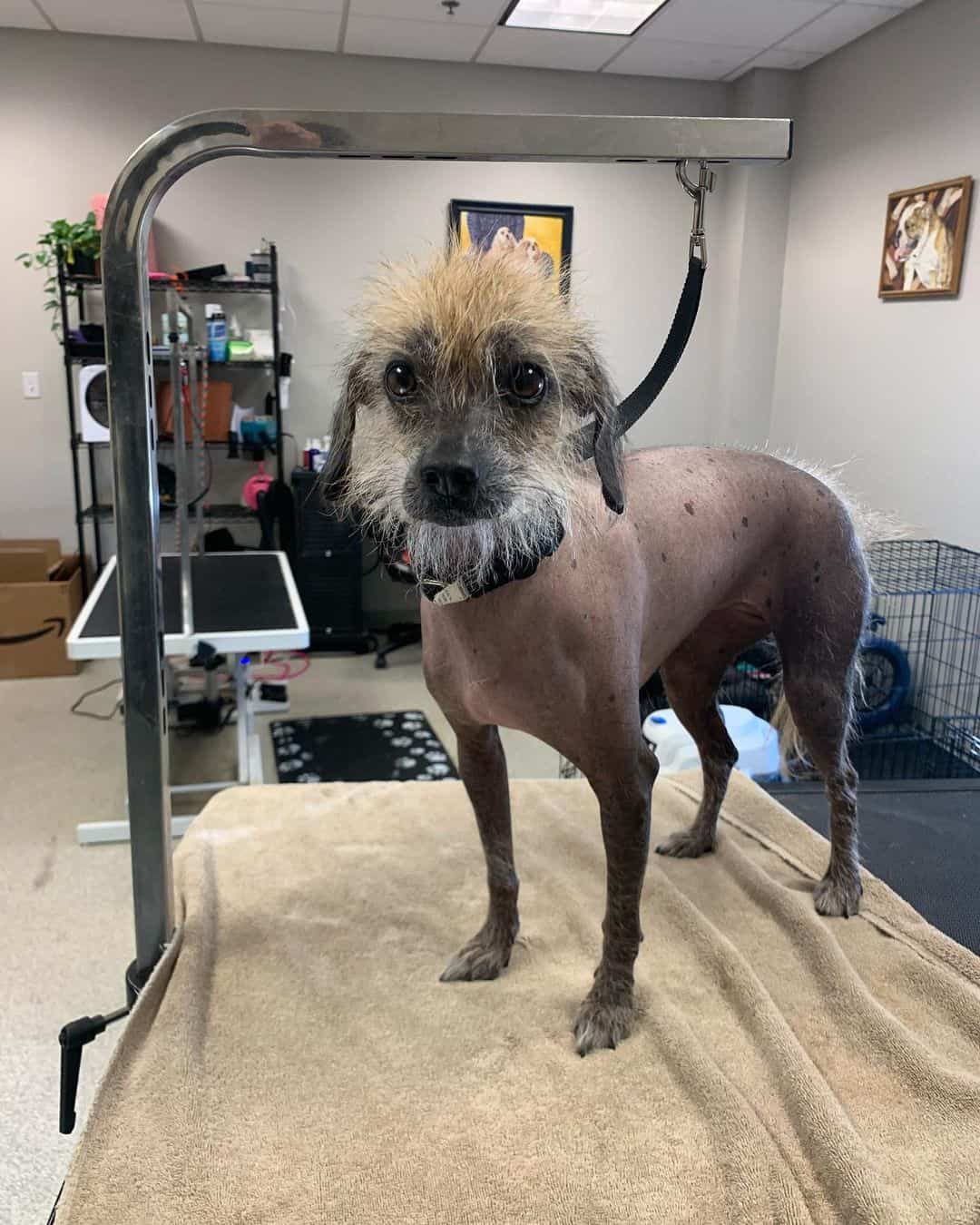
Photo from:@thedogstopmiddletown
This is one of the rarest hairless dog breeds and it comes from Bolivia (I suppose this wasn’t too difficult to guess).
However, the Bolivian Hairless dog isn’t just the name of a single dog breed, but of two distinctive types of Hairless Khalas known as the Khala Grande and the Khala Medio.
The Khala Grande represents a sighthound canine with a larger but slimmer body constitution than the Khala Medios, which might be shorter but is more robust.
These canines are considered primitive, which means that they weren’t produced for a particular reason or role. Therefore, these canines evolved organically into both hunting dogs and companion hounds throughout the course of their history.
Temperament
These canines exhibit a great number of personality traits and features of primitive canines.
In spite of the fact that these pups can eventually start loving family life, they’re still far from being open to unfamiliar people. That is why they keep their distance from all people who don’t seem familiar enough to them.
This is why early socialization is crucial for this breed and other dog breeds with similar temperaments.
The first step you need to fulfill in order to train your pup successfully, is to establish dominance over the canine and let it know that you’re going to be there no matter what.
Hairless Khalas are indeed one of the best examples of introverted dogs (yes, animals can also be introverts or extroverts).
How To Groom Hairless Dog Breeds
Just because they don’t have coat hair, doesn’t mean that hairless dog breeds don’t require grooming.
Of course, the whole process is much easier than with canines such as long-haired Dachshunds, Akita Inus, Golden Retrievers, and other long haired breeds.
Regular baths are a must because their skin is open and prone to all types of infections or damage from sunburn.
When it comes to soaps, I’d recommend that you go with a shampoo that is based on oatmeal rather than those with a high level of chemicals, which might ruin your dog’s skin.
Also, make sure to use moisturizing creams and lotions before you leave the house and after baths, because their skin is super sensitive.
I know this might seem like a tedious task, but once you get started, it’ll be a piece of cake!
I mean, isn’t it a great benefit to not have to brush the canine’s dense coat every day and still find tufts of hair all around the house?
No More Fleas And Dander?
Having a hairless dog is a dream come true, not only for people who suffer from allergic reactions but also for those who can’t stand bugs, including ticks and fleas.
Fleas, dander, and excessive hair around the house are a thing of the past, which means that there’s no need to vacuum twice a day!
Of course, there’s an exception to every rule, and the same applies to these statements. Fleas might appear in some hairless dog breeds, but only if they’re not regularly groomed or if they’re entirely neglected.
The same goes for dander – if the skin is dried out, there is a high chance that you might find it on your canine’s bed, your sofa, or your lap if your pup loves to sit on you!
Of course, if you’re not a big fan of hairless canines, you can always choose the pup you like the most, even if it has a full coat.
Are Hairless Dogs Near Extinction?
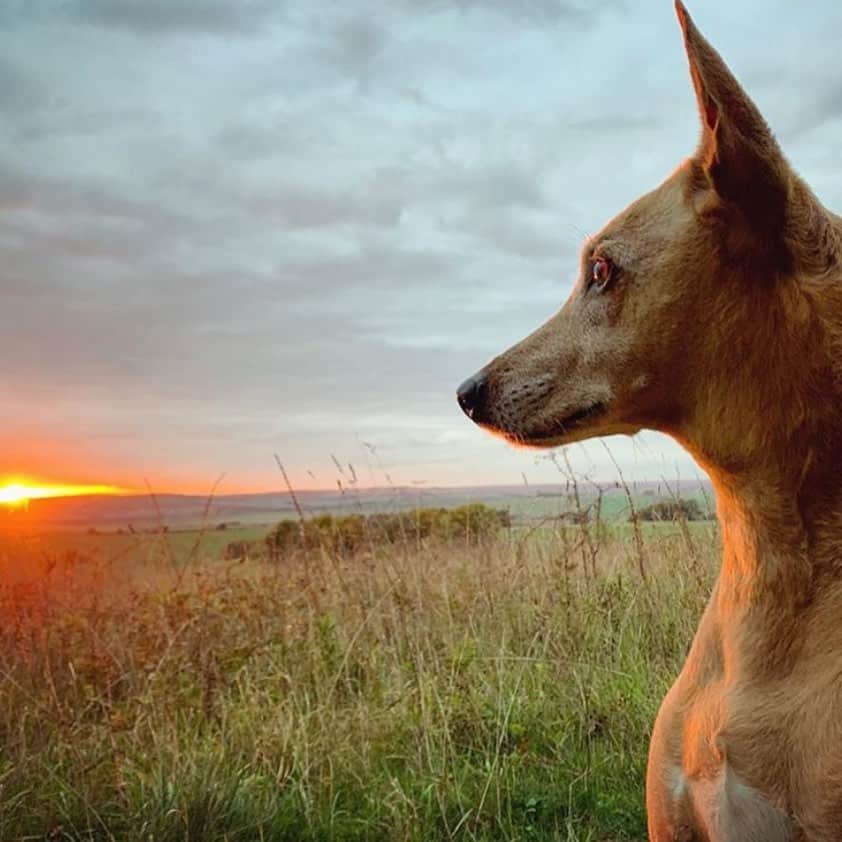
Photo from:@dogsatsunset
Hairless dogs in general won’t be extinct for a long time, but certain breeds, unfortunately, have already disappeared, primarily because of the low demand for hairless dog breeds.
There’s a great number of canine breeds that haven’t managed to prolong their kind. If it wasn’t for Chihuahuas and the hairless Chinese Crested, everyone would have forgotten about the hairless breeds long ago.
Some of the canine breeds that no longer exist are the:
• Thai Hairless Boran dog
• Ceylon Hairless dog
• Guatemalan Hairless dog
• Turkish Hairless dog
• Egyptian Hairless dog
• Nubian dog
• African Sand dog
• Mayan Hairless dog
• African Elephant dog
• Small African Greyhound, etc.
In case you’re wondering how to prevent the extinction of breeds that are still present in the U.S., all you need to do is look for a reputable breeder or a rescue center that might have one of these pups ready for adoption.
This is the most effective way to save these adorable canines and prolong their kind.
Wrapping Up
There might not be plenty of hairless dog breeds available anymore, which is why it’s of the utmost importance to protect those that are left.
These lovely canines might appear delicate at first, mainly because of their skin, which is directly exposed to sunlight and other external factors that might have a negative impact on it.
However, with proper care and the right products, your hairless dog’s skin can look impeccable.
Hairless canines are generally lower in demand, simply because they don’t look like an “ordinary pet.” However, don’t let their physical appearance overshadow all the qualities that these amazing pooches have.
I’m sure that they’ll amaze you if you give them the chance to prove their qualities!
READ NEXT:
• Teacup Chihuahua: The Tiniest Dog With A Huge Backstory
• Weird Dog Breeds: Your Guide To The Weirdest Dogs Ever!
• 19 Shy Dog Breeds: Meet The Timid Side Of Our Furry Friends















